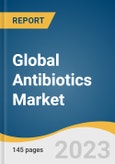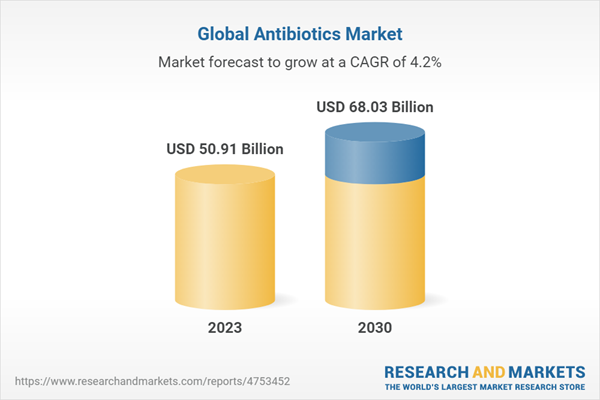The global antibiotics market size is expected to reach USD 68.03 billion by 2030, registering a CAGR of 4.2% from 2024 to 2030. High demand, increasing focus on antibiotic resistance programs, initiatives undertaken to avoid the misuse of antibiotics, and easy availability of generic drugs are responsible for market growth. The purchasing process of antibiotics is primarily influenced by physicians. The availability of multiple generic products provides buyers with easy switching options. In the case of institutional businesses, price discounts play an important role in the selection procedure. This can further reduce the profit margins of market players. However, buyers do not have these privileges in branded or patented products.
Furthermore, regulatory authorities have issued the guidelines for limited use of fluoroquinolones. Hence, the bargaining power of buyers is anticipated to be low over the forecast period. According to the State of World’s Antibiotics report, in 2021, the overall antimicrobial drug usage in India has increased sharply by 30%. Moreover, according to the CDC’s Antibiotics Usage in United States report, 2021 update, around 25 million prescriptions were dispensed from U.S. retail pharmacies. Among them, azithromycin was the leading formulation prescribed in 2021. Thus, the rising consumption pattern of antibacterial drugs is likely to fuel the market growth during the projected period. New product approvals and launches are expected to support market growth.
For instance, in June 2020, the U.S. FDA announced the approval of Recarbrio, a combination of cilastatin-imipenem and relebactam, for the treatment of ventilator-associated bacterial pneumonia and hospital-acquired bacterial pneumonia. The product was first approved for intra-abdominal infections and Urinary Tract Infections (UTIs) in July 2019. In the upcoming years, market growth is projected to be driven by governmental measures, such as the Generating Antibiotics Incentives Now Act, Global Research on Antimicrobial Resistance (GRAM) Project, and the Global Antibiotic Research & Development Partnership (GARDP). Moreover, these organizations are expected to propel the process of developing cutting-edge advanced medications and smoothen the approval process of antibiotic drugs.
This product will be delivered within 2 business days.
Furthermore, regulatory authorities have issued the guidelines for limited use of fluoroquinolones. Hence, the bargaining power of buyers is anticipated to be low over the forecast period. According to the State of World’s Antibiotics report, in 2021, the overall antimicrobial drug usage in India has increased sharply by 30%. Moreover, according to the CDC’s Antibiotics Usage in United States report, 2021 update, around 25 million prescriptions were dispensed from U.S. retail pharmacies. Among them, azithromycin was the leading formulation prescribed in 2021. Thus, the rising consumption pattern of antibacterial drugs is likely to fuel the market growth during the projected period. New product approvals and launches are expected to support market growth.
For instance, in June 2020, the U.S. FDA announced the approval of Recarbrio, a combination of cilastatin-imipenem and relebactam, for the treatment of ventilator-associated bacterial pneumonia and hospital-acquired bacterial pneumonia. The product was first approved for intra-abdominal infections and Urinary Tract Infections (UTIs) in July 2019. In the upcoming years, market growth is projected to be driven by governmental measures, such as the Generating Antibiotics Incentives Now Act, Global Research on Antimicrobial Resistance (GRAM) Project, and the Global Antibiotic Research & Development Partnership (GARDP). Moreover, these organizations are expected to propel the process of developing cutting-edge advanced medications and smoothen the approval process of antibiotic drugs.
Antibiotics Market Report Highlights
- Owing to the dearth of commercial success of newly developed antibiotics, government & non-government bodies implemented certain strategies to incentivize antibacterial drug R&D activities
- For instance, the government alliance with BARDA is supporting various companies to facilitate R&D activities in novel therapies for infectious diseases. BARDA has been associated with several pharmaceutical companies like AstraZeneca and GSK plc
- The cell wall synthesis inhibitor segment held the largest share in 2023 owing to its wide spectrum of activity against gram-positive and gram-negative bacteria
- The RNA synthesis inhibitors segment is anticipated to register the fastest CAGR from 2024 to 2030 due to a surge in product launches and R&D initiatives
- The generic type segment held the largest share in 2023 due to the affordability of generic formulations and government initiatives to adopt generic drugs
- The penicillin drug class segment led the market in 2023. However, the cephalosporin segment is anticipated to register the fastest CAGR from 2024 to 2030
- Asia-Pacific is expected to exhibit the fastest CAGR over the forecast period due to the rising investments by leading players and the high adoption of generic antibiotics in the region
This product will be delivered within 2 business days.
Table of Contents
Chapter 1. Methodology and Scope
Chapter 2. Executive Summary
Chapter 3. Antibiotics Market Variables, Trends & Scope
Chapter 4. Antibiotics Market: Drug Class Estimates & Trend Analysis
Chapter 5. Antibiotics Market: Type Estimates & Trend Analysis
Chapter 6. Antibiotics Market: Action Mechanism Estimates & Trend Analysis
Chapter 7. Antibiotics Market: Regional Estimates & Trend Analysis
Chapter 8. Competitive Landscape
List of Tables
List of Figures
Companies Mentioned
- AbbVie, Inc.
- Pfizer Inc.
- Novartis AG
- Merck & Co., Inc.
- Teva Pharmaceutical Industries Ltd.
- Lupin Pharmaceuticals, Inc.
- Viatris, Inc.
- Melinta Therapeutics LLC
- Cipla, Inc.
- Shionogi & Co., Ltd.
- KYORIN Pharmaceutical Co., Ltd.
- GSK plc
- Nabriva Therapeutics PLC
Methodology

LOADING...
Table Information
| Report Attribute | Details |
|---|---|
| No. of Pages | 145 |
| Published | December 2023 |
| Forecast Period | 2023 - 2030 |
| Estimated Market Value ( USD | $ 50.91 Billion |
| Forecasted Market Value ( USD | $ 68.03 Billion |
| Compound Annual Growth Rate | 4.2% |
| Regions Covered | Global |
| No. of Companies Mentioned | 13 |









